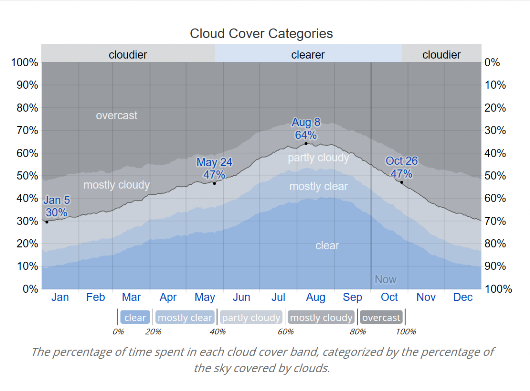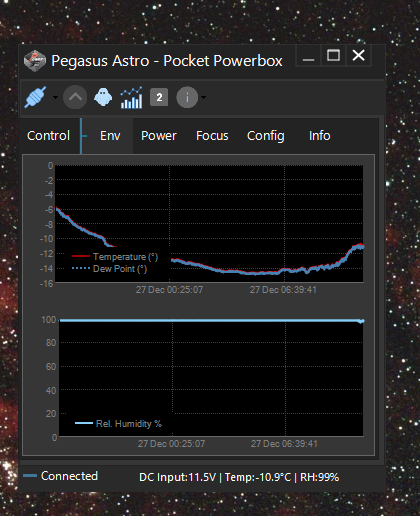
Ah, the weather in Canada. Between early November and Christmas there have only been one or two reasonable nights for Astrophotography. I was not available on those nights, so this blog has been quiet for quite a while!
A graph of the cloud cover in Ottawa is shown below. I doubt we've had 10% clear skies, but even if we did they may have been largely in the daytime and not at night, or in short periods unsuitable for my imaging. Given weather patterns like this it is no surprise that I have not had any clear skies lately.

One more image by way of an excuse... The image below is the measured relative humidity and temperature from a brief observing run last night (yes, Santa brought some clear skies). The Powerbox is used to distribute 12V power and manages a heater system to reduce the dew on the optics. When I set up the telescope (rolled away the cover, connected the cables) it was minus 6 Centigrade. Within a few hours it had dropped to minus 12, hitting a minimum at minus 15. I think the equipment is certified to operate above minus 10 Centigrade. The equipment ran until the morning, with the temperature rising before I rose myself. It was minus 11 when I put things away in the morning.
Worse than the temperature is the other graph, relative humidity. The relative humidity was at 100% all night, meaning the air was saturated with humidity and could form frost at any moment.

Enough of that. What of the stars?
After fixing a cable disconnect at midnight (at minus 14?) I pointed the telescope at Messier 109 (M109), a barred spiral galaxy in Ursa Major. I've imaged this galaxy before - Ursa Major is very well placed for observations - but the quality of that image left a lot to be desired. I decided to run it all night, hoping that the conditions would remain favourable. Moonrise ended the good observations, around 4am. I'm quite happy with the resulting image.
M109 is very close to one of the bright seven stars that make up the big dipper, Phecda. It is one of the two stars defining the bottom of the scoop - the one nearest the handle. The galaxy is not exactly face-on, with one axis greater than the other. The apparent size is around 8 by 5 arc minutes. You may recall that the moon has an apparent diameter of 30 arc minutes.
M109 is the largest galaxy is a very large cluster of galaxies known as the "M109 Group" or the "Ursa Major Cloud". This group may include as many as 50 galaxies. A quick scan of my (cropped) image will reveal two other galaxies, and in the original (uncropped) image I see several more.
M109's main claim to fame is that it is the most distant of the 110 objects in Messier's catalog, and by a fair margin. Given this, it is no surprise to learn that it is quite large: approximately the same diameter and number of stars as Andromeda our nearest neighbor. However Andromeda is 2.5 million light years away from us, while M109 is estimated to be 83.5 million light years away.
Edwin Hubble (for whom the telescope was named) created a scheme to organize galaxy types. The main types he identified were Spiral, Elliptical and Lenticular. Of the spiral type, roughly half of them are barred spirals. The Milky Way is classified as a barred spiral and maps of the galaxy look surprisingly like the image above of M109 (if we tilted it to be face-on).
This image of M109 is comprised of approximately 4 hours of data (1 minute subframes), observed Dec 27, 2021 at Lac Teeples. Telescope RASA11, Camera ZWO ASI 6200.

Comentarios